Papers by Magnus Ivarsson

Minerals, Dec 3, 2019
The production of H 2 in hydrothermal systems and subsurface settings is almost exclusively assum... more The production of H 2 in hydrothermal systems and subsurface settings is almost exclusively assumed a result of abiotic processes, particularly serpentinization of ultramafic rocks. The origin of H 2 in environments not hosted in ultramafic rocks is, as a rule, unjustifiably linked to abiotic processes. Additionally, multiple microbiological processes among both prokaryotes and eukaryotes are known to involve H 2-production, of which anaerobic fungi have been put forward as a potential source of H 2 in subsurface environments, which is still unconfirmed. Here, we report fungal remains exceptionally preserved as fluid inclusions in hydrothermal quartz from feeder quartz-barite veins from the Cape Vani Fe-Ba-Mn ore on the Greek island of Milos. The inclusions possess filamentous or near-spheroidal morphologies interpreted as remains of fungal hyphae and spores, respectively. They were characterized by microthermometry, Raman spectroscopy, and staining of exposed inclusions with WGA-FITC under fluorescence microscopy. The spheroidal aqueous inclusions interpreted as fungal spores are unique by their coating of Mn-oxide birnessite, and gas phase H 2. A biological origin of the H 2 resulting from anaerobic fungal respiration is suggested. We propose that biologically produced H 2 by micro-eukaryotes is an unrecognized source of H 2 in hydrothermal systems that may support communities of H 2-dependent prokaryotes.
Goldschmidt Abstracts, 2020

International Journal of Astrobiology, Apr 1, 2008
Laser-ablation inductively coupled plasma mass spectroscopy analyses have been performed on carbo... more Laser-ablation inductively coupled plasma mass spectroscopy analyses have been performed on carbonaceous filamentous structures that have been interpreted as fossilized microorganisms containing ~10–50 wt% Fe and on non-carbonaceous filamentous structures that have been interpreted to have been formed abiotically containing ~80 wt% Fe. The obtained laser-ablation profiles of the two structural types show a distinct difference in the iron isotopic variations. The centers of the carbonaceous filaments are enriched in 57Fe and 58Fe and depleted in 56Fe. The surficial parts of the filaments display an opposite behavior of the iron isotopes and are thus enriched in 56Fe and depleted in 57Fe and 58Fe. 54Fe usually follows 57Fe and 58Fe but in some cases it follows 56Fe instead. The outer, surficial parts enriched in 56Fe have been interpreted as iron oxides precipitated on the surfaces of the microorganisms as they mediate oxidation of the iron to achieve metabolic energy. The laser-ablation profiles of the abiotically formed non-carbonaceous filamentous structures do not show the same characteristics as the carbonaceous filaments but only irregular elevations of 56Fe. The characteristic profile patterns of the isotope variations in the microfossils suggest that microbially formed iron oxides may be enriched in 56Fe. If that is the case the isotopic profiles could be used to distinguish abiotically formed iron oxides from biologically formed oxides.

Astrobiology, Sep 1, 2011
We report the discovery of fossilized filamentous structures in samples of the lithified, volcani... more We report the discovery of fossilized filamentous structures in samples of the lithified, volcaniclastic apron of Gran Canaria, which were obtained during Leg 157 of the Ocean Drilling Program (ODP). These filamentous structures are 2-15 μm in diameter and several hundred micrometers in length and are composed of Si, Al, Fe, Ca, Mg, Na, Ti, and C. Chitin was detected in the filamentous structures by staining with wheat germ agglutinin dye conjugated with fluorescein isothiocyanate (WGA-FITC), which suggests that they are fossilized fungal hyphae. The further elucidation of typical filamentous fungal morphological features, such as septa, hyphal bridges, and anastomosis and their respective sizes, support this interpretation. Characteristic structures that we interpreted as fossilized spores were also observed in association with the putative hyphae. The fungal hyphae were found in pyroxene phenocrysts and in siderite pseudomorphs of a basalt breccia. The fungal colonization of the basalt clasts occurred after the brecciation but prior to the final emplacement and lithification of the sediment at ∼16-14 Ma. The siderite appears to have been partially dissolved by the presence of fungal hyphae, and the fungi preferentially colonized Fe-rich carbonates over Fe-poor carbonates (aragonite). Our findings indicate that fungi may be an important geobiological agent in subseafloor environments and an important component of the deep subseafloor biosphere, and that hydrothermal environments associated with volcanism can support a diverse ecosystem, including eukaryotes.
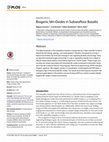
PLOS ONE, Jun 24, 2015
The deep biosphere of the subseafloor basalts is recognized as a major scientific frontier in dis... more The deep biosphere of the subseafloor basalts is recognized as a major scientific frontier in disciplines like biology, geology, and oceanography. Recently, the presence of fungi in these environments has involved a change of view regarding diversity and ecology. Here, we describe fossilized fungal communities in vugs in subseafloor basalts from a depth of 936.65 metres below seafloor at the Detroit Seamount, Pacific Ocean. These fungal communities are closely associated with botryoidal Mn oxides composed of todorokite. Analyses of the Mn oxides by Electron Paramagnetic Resonance spectroscopy (EPR) indicate a biogenic signature. We suggest, based on mineralogical, morphological and EPR data, a biological origin of the botryoidal Mn oxides. Our results show that fungi are involved in Mn cycling at great depths in the seafloor and we introduce EPR as a means to easily identify biogenic Mn oxides in these environments.
Origins of Life and Evolution of Biospheres, 2010
su.se. ...

Earth-Science Reviews, Nov 1, 2020
The fossil record of igneous rock constitutes a new paleobiological archive that is largely under... more The fossil record of igneous rock constitutes a new paleobiological archive that is largely underexplored with respect to abundance, taxonomy, and taphonomy. This record represents the fossilized remains of the deep biosphere: microorganisms that live in open pore spaces in the rock and subsequently become fossilized in situ. So far, most of the investigations have been carried out on subseafloor basalts, but ultramafic rocks as well as continental granites have been shown to contain similar fossils. Currently, the fossil archive ranges from present to 2.4 Ga, indicating that these deep environments have been inhabited by microorganisms from, at least, the Paleoproterozoic. The fossils have been interpreted as both eukaryotes and prokaryotes but, surprisingly, a majority of the fossils consist of fungal remains. Consortia of fungi and prokaryotes are common, which suggests frequent symbiotic relationships between both. A symbiotic lifestyle is most likely a prerequisite for colonization of, and survival in deep, extreme environments.
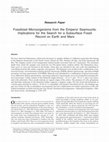
We have observed filamentous carbon-rich structures in samples drilled at 3 different seamounts t... more We have observed filamentous carbon-rich structures in samples drilled at 3 different seamounts that belong to the Emperor Seamounts in the Pacific Ocean: Detroit (81 Ma), Nintoku (56 Ma), and Koko Seamounts (48 Ma). The samples consist of low-temperature altered basalts recovered from all 3 seamounts. The maximum depth from which the samples were retrieved was 954 meters below seafloor (mbsf). The filamentous structures occur in veins and fractures in the basalts, where they are attached to the vein walls and embedded in vein-filling minerals like calcite, aragonite, and gypsum. The filaments were studied with a combination of optical microscopy, environmental scanning electron microscopy (ESEM), Raman spectroscopy, and time-of-flight secondary ion mass spectrometry (ToF-SIMS). Minerals were identified by a combination of optical microscopy, X-ray diffraction, Raman spectrometry, and energy dispersive spectrometry on an environmental scanning electron microscope. Carbon content of the filaments ranges between ϳ10 wt % and ϳ50 wt % and is not associated with carbonates. These results indicate an organic origin of the carbon. The presence of C 2 H 4 , phosphate, and lipid-like molecules in the filaments further supports a biogenic origin. We also found microchannels in volcanic glass enriched in carbon (ϳ10-40 wt %) compatible with putative microbial activity. Our findings suggest new niches for life in subseafloor environments and have implications for further exploration of the subseafloor biosphere on Earth and beyond.
BioEssays, Apr 19, 2020
A growing awareness of a subsurface fossil record of mostly hyphal fungi organisms stretching bac... more A growing awareness of a subsurface fossil record of mostly hyphal fungi organisms stretching back through the Phanerozoic to ≈400 megaannum (Ma) and possibly earlier, provides an alternative view on hyphal development. Parallel with the emergence of hyphal fungi during Ordovician-Devonian times when plants colonized the land, which is the traditional notion of hyphal evolution, hyphae-based fungi existed in the deep biosphere. New insights suggest that the fundamental functions of hyphae may have evolved in response to an ancient subsurface endolithic life style and might have been in place before the colonization of land. To address the gaps in the current understanding of hyphal evolution a strategy based on research prospects involving investigations of uncharted geological material, new diagnostics, and comparisons to live species is proposed.
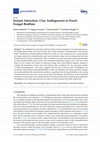
Geosciences, Aug 24, 2019
Clay authigenesis associated with the activity of microorganisms is an important process for biof... more Clay authigenesis associated with the activity of microorganisms is an important process for biofilm preservation and may provide clues to the formation of biominerals on the ancient Earth. Fossilization of fungal biofilms attached to vesicles or cracks in igneous rock, is characterized by fungal-induced clay mineralization and can be tracked in deep rock and deep time, from late Paleoproterozoic (2.4 Ga), to the present. Here we briefly review the current data on clay mineralization by fossil fungal biofilms from oceanic and continental subsurface igneous rock. The aim of this study was to compare the nature of subsurface fungal clays from different igneous settings to evaluate the importance of host rock and ambient redox conditions for clay speciation related to fossil microorganisms. Our study suggests that the most common type of authigenic clay associated with pristine fossil fungal biofilms in both oxic (basaltic) and anoxic (granitic) settings are montmorillonite-like smectites and confirms a significant role of fungal biofilms in the cycling of elements between host rock, ocean and secondary precipitates. The presence of life in the deep subsurface may thus prove more significant than host rock geochemistry in directing the precipitation of authigenic clays in the igneous crust, the extent of which remains to be fully understood.
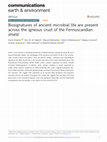
Communications earth & environment, Jun 3, 2021
Earth's crust contains a substantial proportion of global biomass, hosting microbial life up to s... more Earth's crust contains a substantial proportion of global biomass, hosting microbial life up to several kilometers depth. Yet, knowledge of the evolution and extent of life in this environment remains elusive and patchy. Here we present isotopic, molecular and morphological signatures for deep ancient life in vein mineral specimens from mines distributed across the Precambrian Fennoscandian shield. Stable carbon isotopic signatures of calcite indicate microbial methanogenesis. In addition, sulfur isotope variability in pyrite, supported by stable carbon isotopic signatures of methyl-branched fatty acids, suggest subsequent bacterial sulfate reduction. Carbonate geochronology constrains the timing of these processes to the Cenozoic. We suggest that signatures of an ancient deep biosphere and long-term microbial activity are present throughout this shield. We suggest that microbes may have been active in the continental igneous crust over geological timescales, and that subsurface investigations may be valuable in the search for extra-terrestrial life.

Recent studies reveal that organisms from all three domains of life—Archaea, Bacteria, and even E... more Recent studies reveal that organisms from all three domains of life—Archaea, Bacteria, and even Eukarya—can thrive under energy-poor, dark, and anoxic conditions at large depths in the fractured crystalline continental crust. There is a need for an increased understanding of the processes and lifeforms in this vast realm, for example, regarding the spatiotemporal extent and variability of the different processes in the crust. Here, we present a study that set out to detect signs of ancient microbial life in the Forsmark area—the target area for deep geological nuclear waste disposal in Sweden. Stable isotope compositions were determined with high spatial resolution analyses within mineral coatings, and mineralized remains of putative microorganisms were studied in several deep water-conducting fracture zones (down to 663 m depth), from which hydrochemical and gas data exist. Large isotopic variabilities of δCcalcite (−36.2 to +20.2‰ V-PDB) and δSpyrite (−11.7 to +37.8‰ V-CDT) disclo...
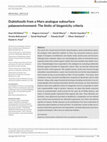
Geobiology, 2021
The search for a fossil record of Earth's deep biosphere, partly motivated by potential analo... more The search for a fossil record of Earth's deep biosphere, partly motivated by potential analogies with subsurface habitats on Mars, has uncovered numerous assemblages of inorganic microfilaments and tubules inside ancient pores and fractures. Although these enigmatic objects are morphologically similar to mineralized microorganisms (and some contain organic carbon), they also resemble some abiotic structures. Palaeobiologists have responded to this ambiguity by evaluating problematic filaments against checklists of “biogenicity criteria”. Here, we describe material that tests the limits of this approach. We sampled Jurassic calcite veins formed through subseafloor serpentinization, a water–rock reaction that can fuel the deep biosphere and is known to have occurred widely on Mars. At two localities ~4 km apart, veins contained curving, branched microfilaments composed of Mg‐silicate and Fe‐oxide minerals. Using a wide range of analytical techniques including synchrotron X‐ray mi...
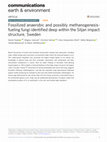
Communications Earth & Environment, 2021
Recent discoveries of extant and fossilized communities indicate that eukaryotes, including fungi... more Recent discoveries of extant and fossilized communities indicate that eukaryotes, including fungi, inhabit energy-poor and anoxic environments deep within the fractured igneous crust. This subterranean biosphere may constitute the largest fungal habitat on our planet, but knowledge of abyssal fungi and their syntrophic interactions with prokaryotes and their concomitant metabolisms is scarce. Here we report findings of fossilized, chitin-bearing fungal hyphae at ~540 m depth in fractured bedrock of the Siljan impact structure, the largest crater in Europe. Strong 13C-enrichment of calcite precipitated with and on the fungi suggests formation following methanogenesis, and that the anaerobic fungi decomposed dispersed organic matter producing for example H2 that may have fueled autotrophic methanogens. An Eocene age determined for the calcite infers the first timing constraint of fossilized fungi in the continental igneous crust. Fungi may be widespread decomposers of organic matter a...
Goldschmidt Abstracts, 2020
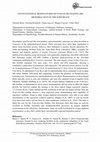
29th International Meeting on Organic Geochemistry, 2019
Micrometre sized Fe-and Mn-rich dendritic and stromatolitic structures are often described as Fru... more Micrometre sized Fe-and Mn-rich dendritic and stromatolitic structures are often described as Frutexites in the palaeontological record. These structures have often been interpreted to derive from microbial activity; however, their formation is unclear. Recent subsurface Feoxide precipitating biofilms from the Äspö Hard Rock Laboratory (HRL) resemble the laminar and dendritic patterns of ancient Frutexites structures (Heim et al., 2017). The analytical investigation using microscopy, next generation sequencing, microbial cultivations and biomarker studies (GC-MS) enabled a detailed characterization of the microbial community inhabiting these Frutexites structures. The total organic extract of this Frutexiteslike biofilm contained 10% fatty acids, 21% sterols and 69% hopanoids, showing a community composition of prokaryotes and eukaryotes. The detected sterols cholest-5-en-3β
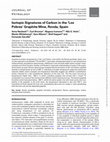
Journal of Petrology, 2020
Graphite formation temperatures in the ‘Los Pobres’ mine within the Ronda peridotite, Spain, prev... more Graphite formation temperatures in the ‘Los Pobres’ mine within the Ronda peridotite, Spain, previously reported to be between 770 and 820 °C, have been reinterpreted based on new temperature measurements using Raman spectroscopy. Additional in situ and bulk stable carbon isotopic measurements and fluid inclusion studies contributed to improved understanding of parts of the graphite formation process. Raman spectroscopy revealed that the formation of the ‘Los Pobres’ graphite extends to temperatures as low as 500 °C, indicating a broader temperature range than previously reported. Stable carbon isotopes and temperature estimates suggest two different crystallization events, followed by a late hydrothermal alteration of the host rock. The first event occurred at temperatures higher than ∼600°C, in which crystalline graphite was formed with a mixed 13C composition as a result of the mixing of two different carbon-bearing sources. The second graphite formation event took place below ∼6...
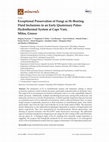
Minerals, 2019
The production of H2 in hydrothermal systems and subsurface settings is almost exclusively assume... more The production of H2 in hydrothermal systems and subsurface settings is almost exclusively assumed a result of abiotic processes, particularly serpentinization of ultramafic rocks. The origin of H2 in environments not hosted in ultramafic rocks is, as a rule, unjustifiably linked to abiotic processes. Additionally, multiple microbiological processes among both prokaryotes and eukaryotes are known to involve H2-production, of which anaerobic fungi have been put forward as a potential source of H2 in subsurface environments, which is still unconfirmed. Here, we report fungal remains exceptionally preserved as fluid inclusions in hydrothermal quartz from feeder quartz-barite veins from the Cape Vani Fe-Ba-Mn ore on the Greek island of Milos. The inclusions possess filamentous or near-spheroidal morphologies interpreted as remains of fungal hyphae and spores, respectively. They were characterized by microthermometry, Raman spectroscopy, and staining of exposed inclusions with WGA-FITC u...
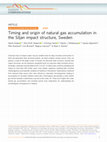
Nature Communications, 2019
Fractured rocks of impact craters may be suitable hosts for deep microbial communities on Earth a... more Fractured rocks of impact craters may be suitable hosts for deep microbial communities on Earth and potentially other terrestrial planets, yet direct evidence remains elusive. Here, we present a study of the largest crater of Europe, the Devonian Siljan structure, showing that impact structures can be important unexplored hosts for long-term deep microbial activity. Secondary carbonate minerals dated to 80 ± 5 to 22 ± 3 million years, and thus postdating the impact by more than 300 million years, have isotopic signatures revealing both microbial methanogenesis and anaerobic oxidation of methane in the bedrock. Hydrocarbons mobilized from matured shale source rocks were utilized by subsurface microorganisms, leading to accumulation of microbial methane mixed with a thermogenic and possibly a minor abiotic gas fraction beneath a sedimentary cap rock at the crater rim. These new insights into crater hosted gas accumulation and microbial activity have implications for understanding the ...








Uploads
Papers by Magnus Ivarsson